
Servo: A new web engine written in Rust
Last weekend we had the opportunity to talk about Servo at GOSIM Hangzhou 2025. This was my first time in Asia, a long trip going there but a wonderful experience nevertheless.
My talk was Servo: A new web engine written in Rust and it was an introductory talk about the Servo project focusing on the evolution since 2023 when Igalia took over the project maintenance. The talk was trying to answer a few questions:
- What’s Servo?
- Is it really a “new” web engine?
- What makes Servo special?
- What’s the project vision?
- How can you help?
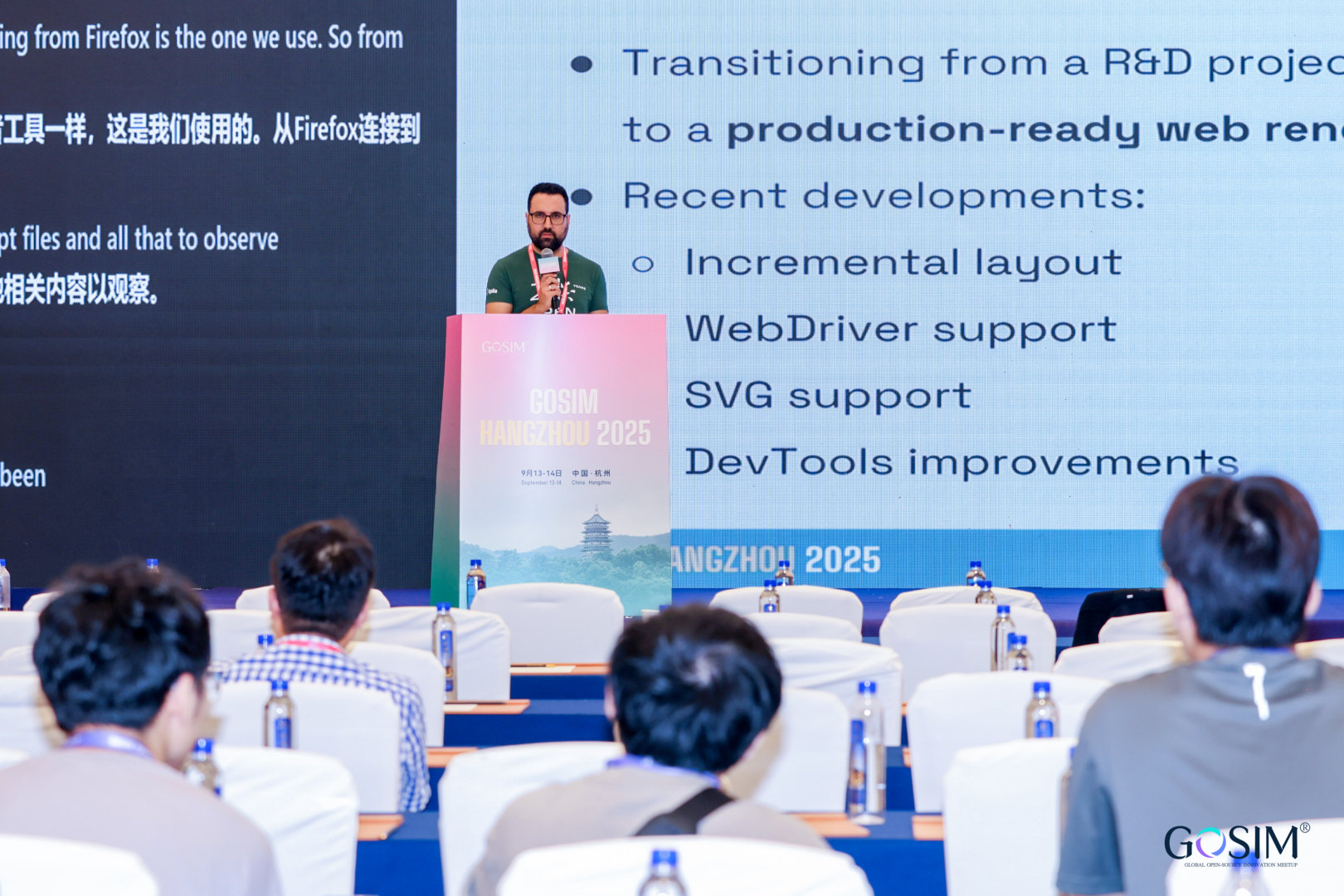
In addition, my colleagues Martin Robinson and Oriol Brufau were also at GOSIM talking about Servo layout engine with their talk A Dive Into the Servo Layout System.
In this blog post I’m going to go over all the slides of the talk and describe the different things I was explaining during the presentation A kind of a reader view of the talk. If you want to check the slides yourself, they’re available online, and the talk recording too.
Servo: A new web engine written in Rust #
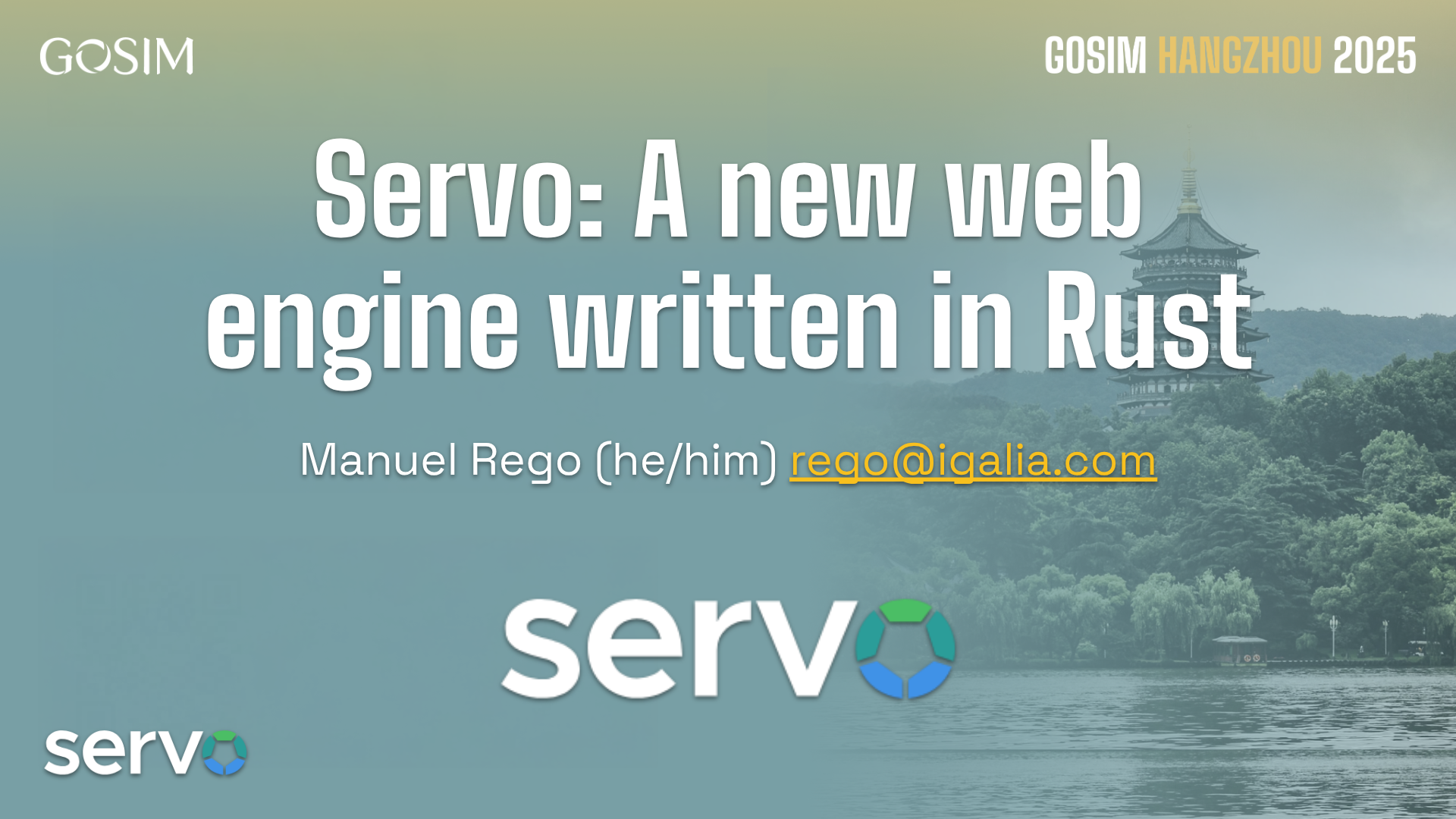
To start the presentation I take the chance to ask the audience about how many knew Servo (just a few); and Chrome, Safari and Firefox (most of them).
About me #
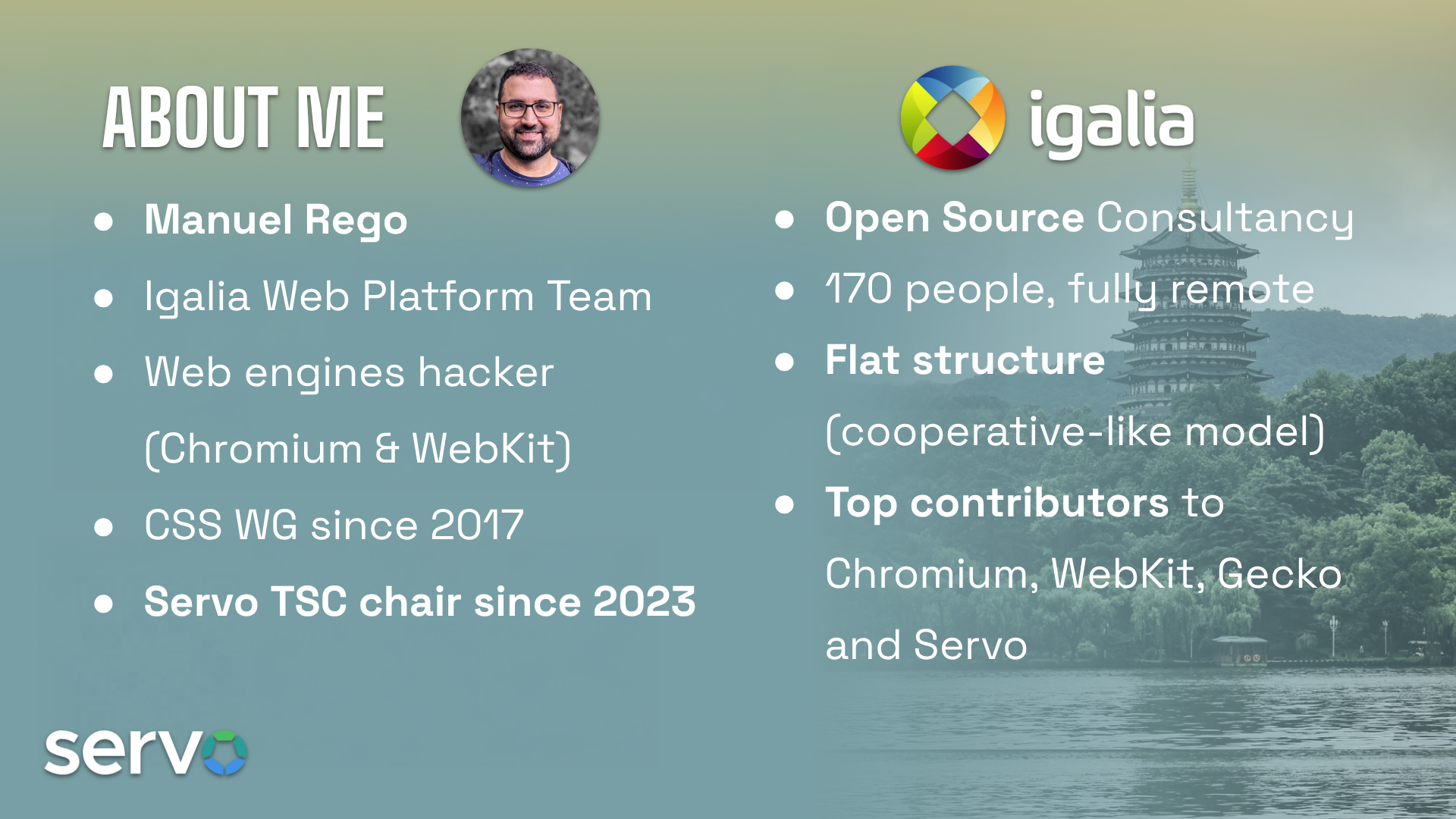
Next a quick introduction about myself and Igalia, nothing very new or fancy here compared to other previous talks I’ve done. Main highlights are that I’m Servo Technical Steering Committee (TSC) chair since 2023, I’m not working on the project as a developer but I’m helping with the coordination efforts. And regarding Igalia that we’re an open source consultancy, with a flat structure, and top contributors to the main web rendering engines.
What’s Servo? ❓ #

First section tries to briefly explain what is Servo, specially for the people that don’t know the project yet and looking into clarifying the question about if it’s a browser, a web engine, or both.
Web Browser vs Web Rendering Engine 🛠️ #
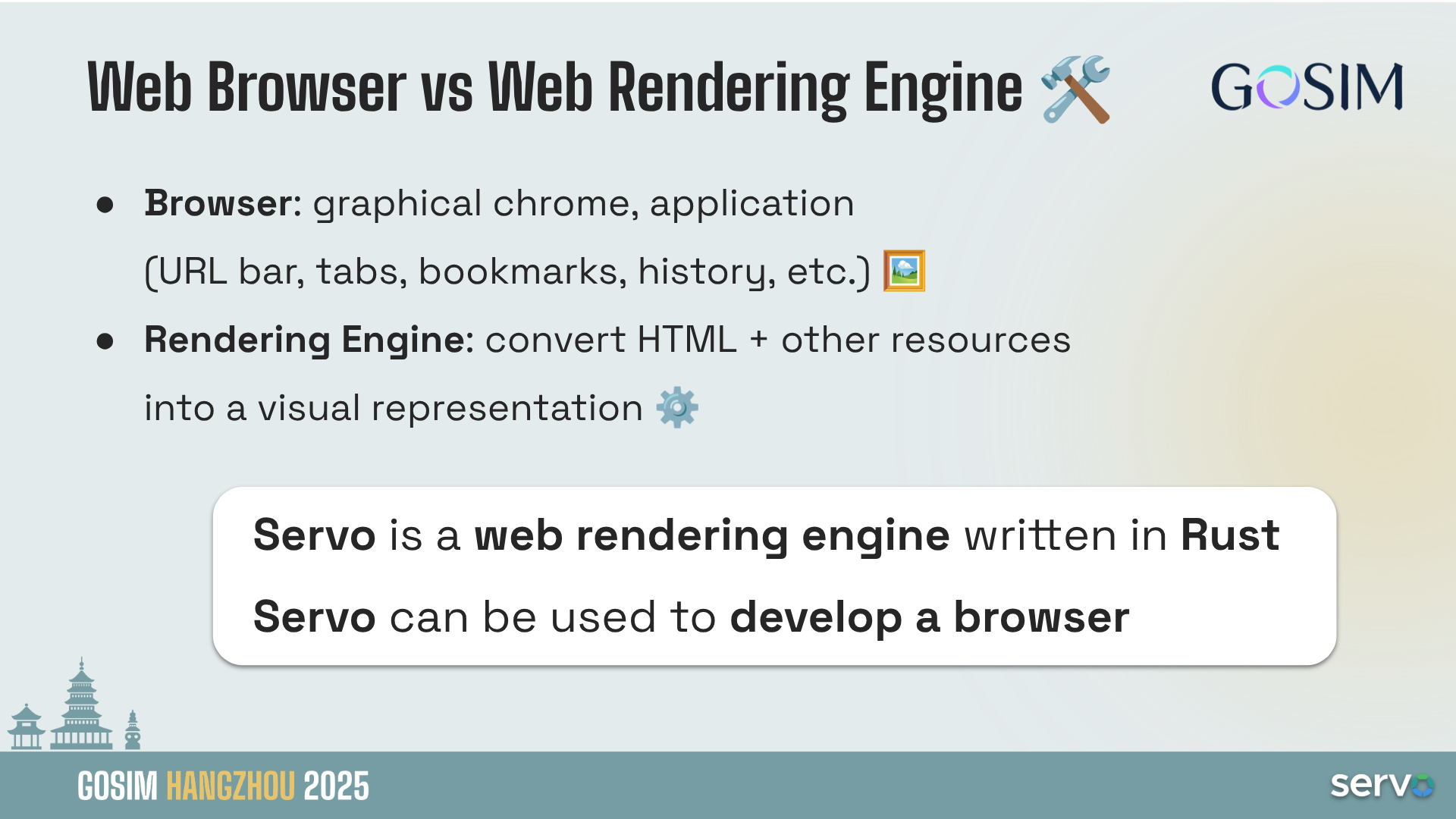
Here the goal is to shortly describe the difference between a web browser and a web rendering engine. If you are confused about these two terms, the browser is the application that you use, the one that has a URL bar, tabs, bookmarks, history, etc. It’s a graphical chrome that allows you to browse the web. The rendering engine is the one in charge of converting the HTML plus the rest of resources (styles, JavaScript, etc.) into a visual representation that is displayed in your screen, a piece of the browser.
I also mention of browsers vs rendering engines, like Chrome and Blink, Safari and WebKit, or Firefox and Gecko.
Regarding Servo there are two things which are both equally true:
- Servo is a web rendering engine written in Rust
- Servo can be used to develop a browser
See it in action! 🎬 #
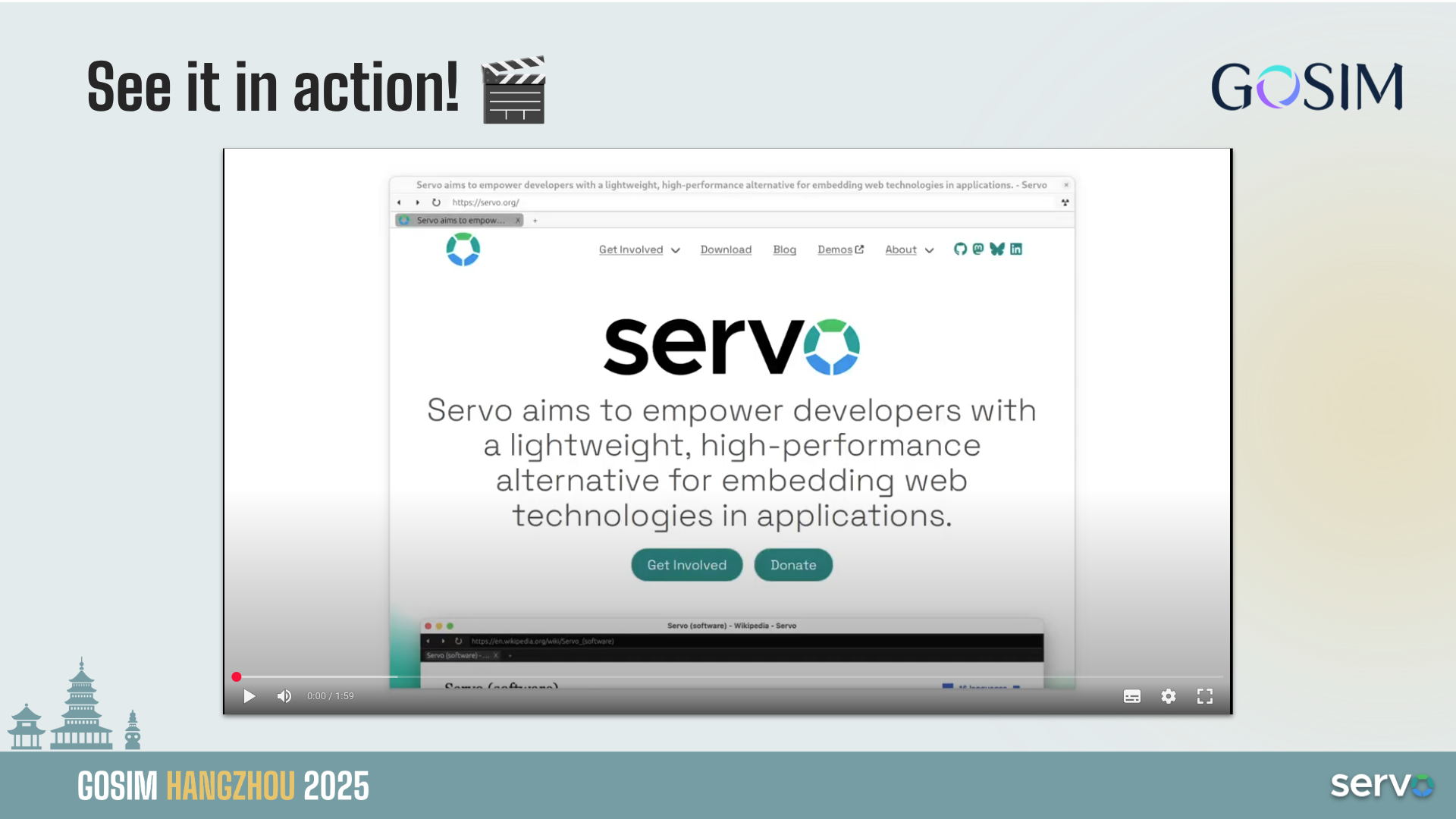
Here we see a video of Servo running, so the audience can understand what it is even better. The video shows servoshell (our minimal browser to test Servo) and stars by browsing servo.org. Then it opens Wikipedia, searches for Python, and opens the Python programming language page. From there it clicks on the Python website, and browses a little bit the documentation. Finally it opens Baidu maps, and searches for the GOSIM conference venue.
Is it really a “new” web engine? 🆕 #
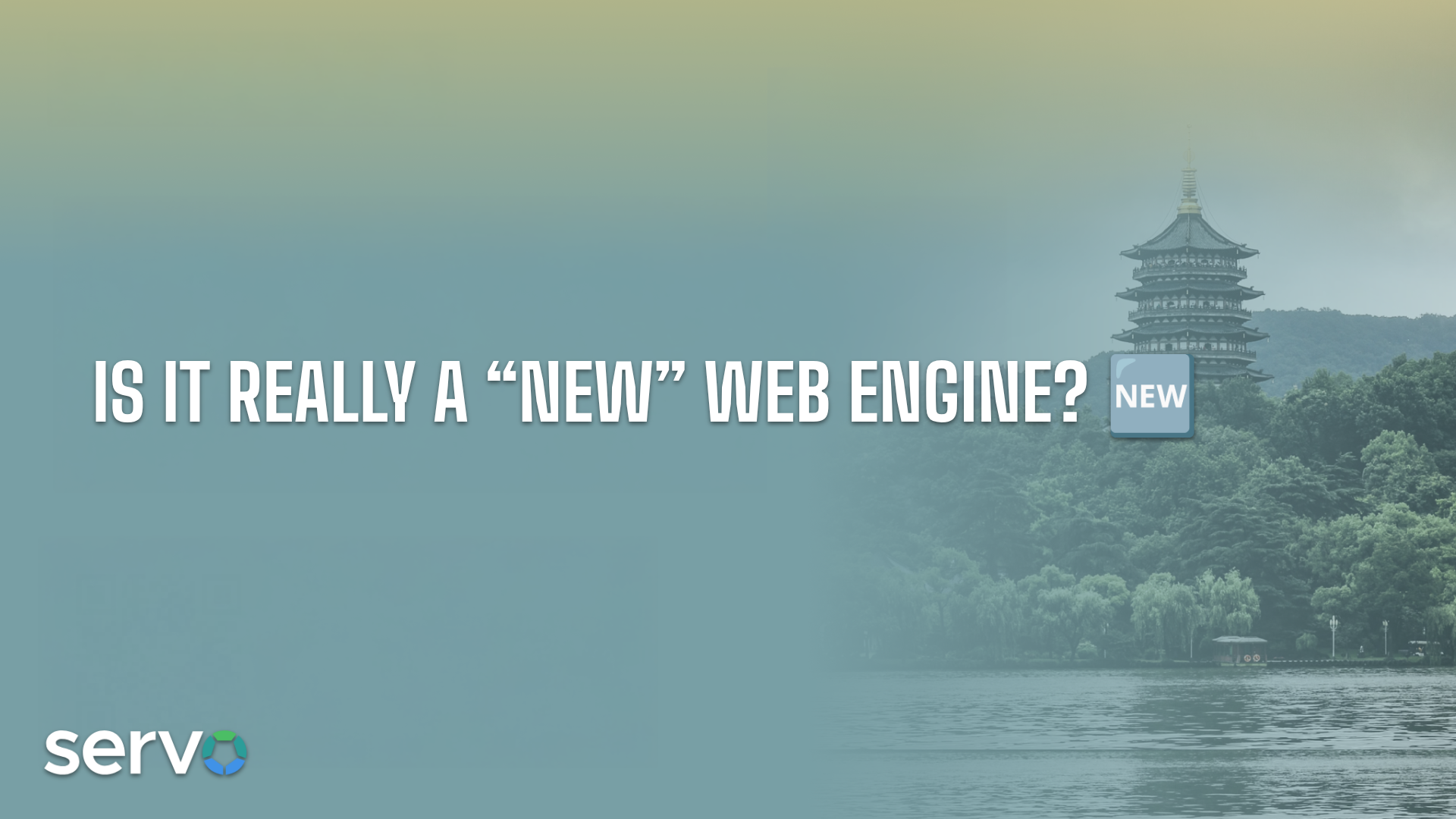
The idea of this section was to review Servo’s history and evolution on the recent years.
Servo’s history 📜 #
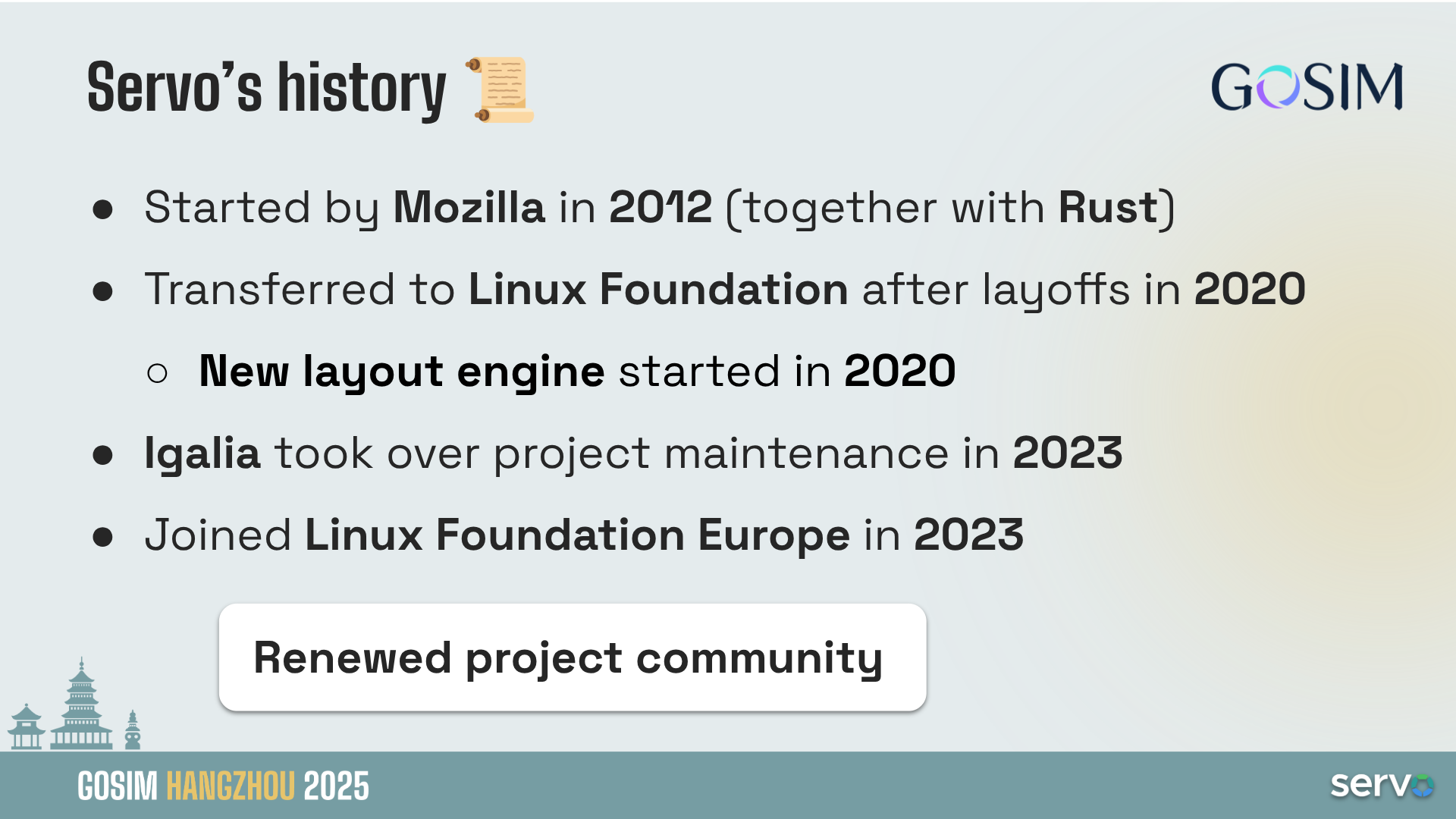
This is a brief summary of Servo’s project history. The project was started by Mozilla in 2012, at that time they were developing the Rust language itself (somehow Mozilla used Servo, a web rendering engine, as a testing project to check that Rust language was good enough). In any case we cannot consider it really “new”, but Servo is way younger than other web engines that started decades before.
In 2020, Mozilla layoff the whole Servo team, and transferred the project to Linux Foundation. That very same year the Servo team had started the work in a new layout engine. The layout engine is an important and complex part of a web engine, it’s the one that calculates the size and position of the different elements of the website. Servo was starting a new layout engine, closer to the specifications language and with similar principles to what other vendors were also doing (Blink with LayoutNG and WebKit with Layout Formatting Context). This was done due to problems in the design of the original layout engine, which prevented to implement properly some CSS features like floats. So, from the layout engine point of view, Servo is quite a “new” engine.
In 2023, Igalia took over Servo project maintenance, with the main goal to bring the project back to life after a couple of years with minimal activity. That very same year the project joined Linux Foundation Europe in an attempt to regain interest from a broader set of the industry.
A highlight is that the project community has been totally renewed and Servo’s activity these days is growing and growing.
Commits stats 📊 #
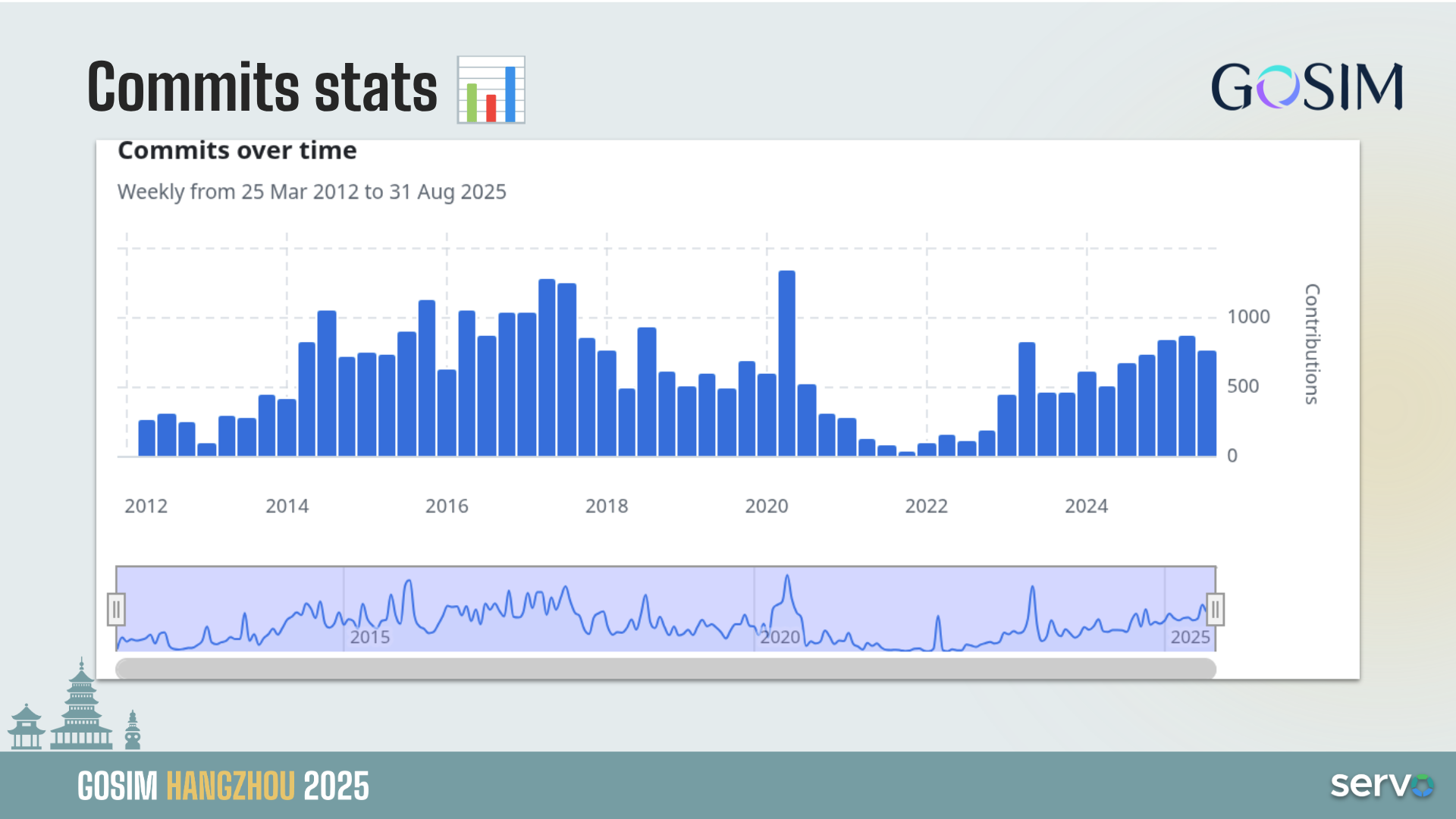
We take a look to the commits stats from GitHub, which show what was explained before. A very low period of activity between 2021 and 2022; and the recent renewed activity on the project.
PRs stats (no bots) 📈 #
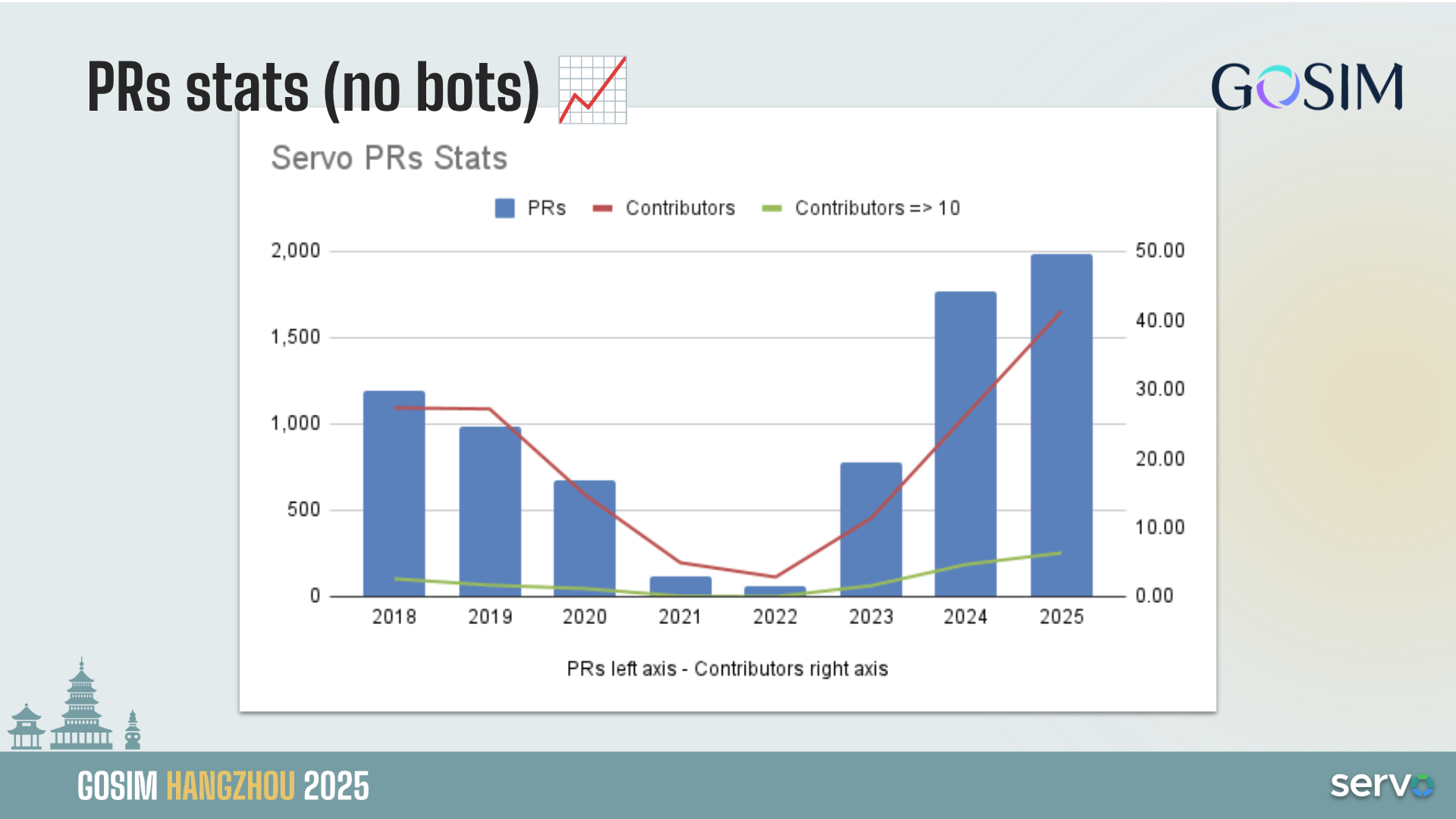
If we zoom a bit the previous chart, we can look into the PRs merged since 2018 (not commits, as a PR can have multiple commits the chart differs a little bit from previous one). The chart also removes the PRs that are done by bots (like dependabot and servo-wpt-sync). Taking a look here we see that the last years have been very good for Servo, we’re now way over the numbers from 2018; almost doubling them in number of merged PRs, average monthly contributors, and average monthly contributors with more than 10 PRs merged in a month. Next is the same data in a table format:
| 2018 | 2019 | 2020 | 2021 | 2022 | 2023 | 2024 | 2025 | |
|---|---|---|---|---|---|---|---|---|
| PRs | 1,188 | 986 | 669 | 118 | 65 | 776 | 1,771 | 1,983 |
| Contributors | 27.33 | 27.17 | 14.75 | 4.92 | 2.83 | 11.33 | 26.33/td> | 41.33 |
| Contributors ≥ 10 | 2.58 | 1.67 | 1.17 | 0.08 | 0.00 | 1.58 | 4.67 | 6.33 |
Legend:
- PRs: total numbers of PRs merged.
- Contributors: average number of contributors per month.
- Contributors ≥ 10: average number of contributors that have merged more than 10 PRs per month.
WPT pass-rates ✅ #
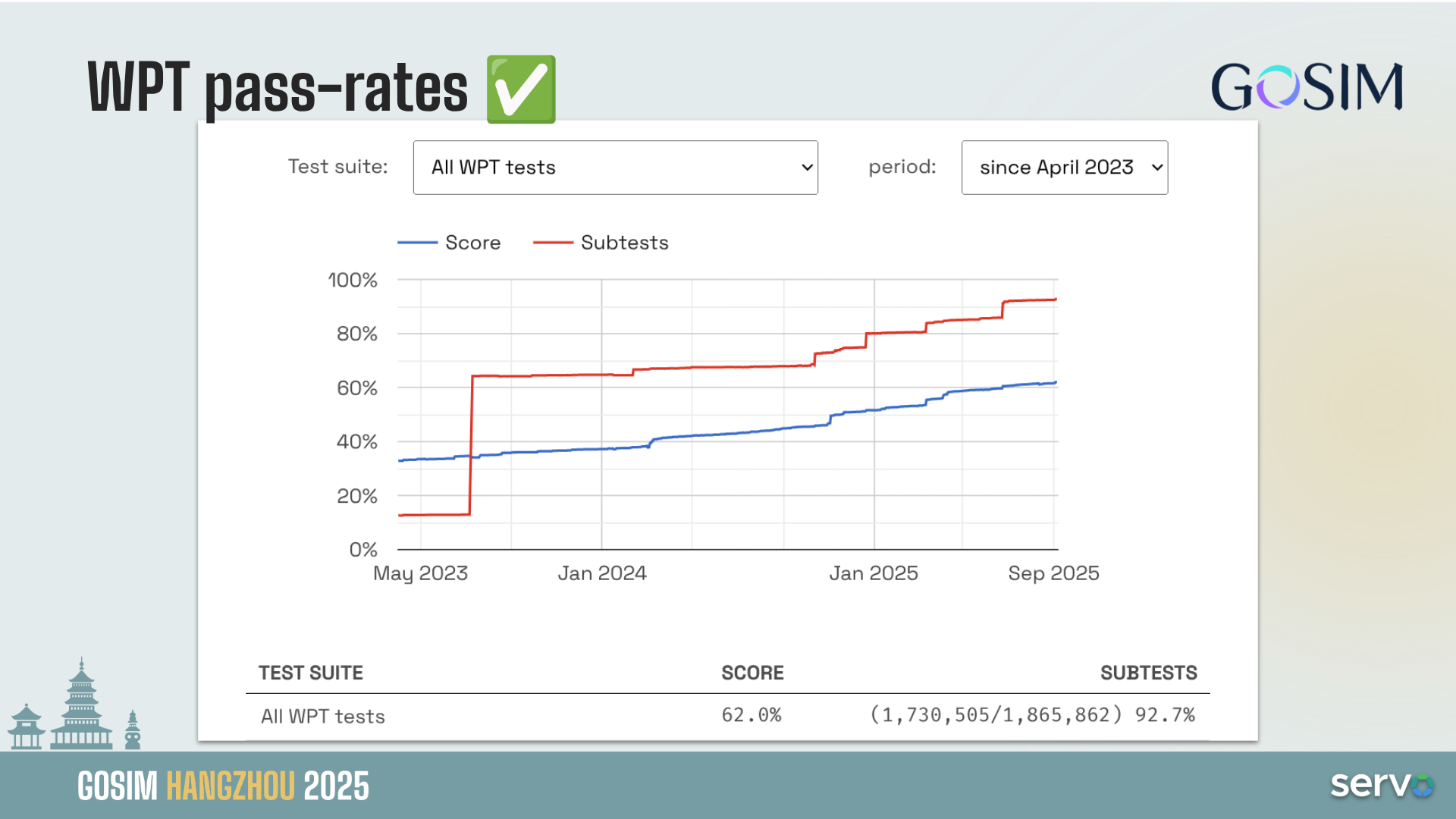
Then we check the WPT pass-rates. WPT is the web platform tests suite, which all the web engines use and share. It consists in almost 2 millions subtests and the chart shows the evolution for Servo since April 2023 (when we started measuring this). It shows that the situation in 2023 was pretty bad, but today Servo is passing more than 1.7 million subtests (a 92.7% of the tests that we run, there are some tests skipped that we don’t count here).
If you are curious about this chart and want to learn more you can visit servo.org/wpt.
New layout engine 🌱 #
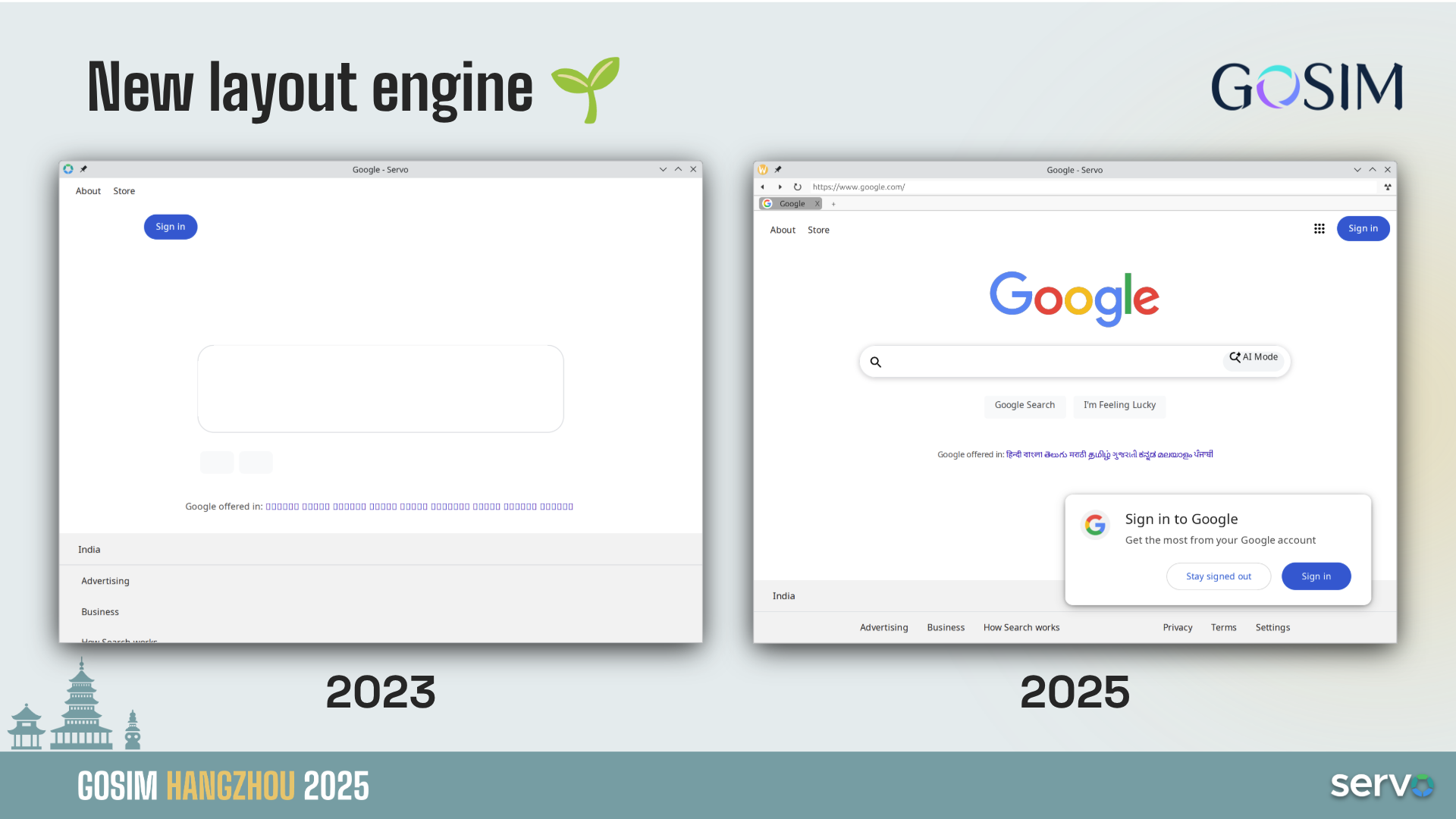
Reflecting more on the layout engine, we show a comparison between how google.com was rendered in 2023 (no logo, no text on the buttons, missing text, no icons, etc.) vs in 2025 (which looks way closer to what you can see in any other browser).
This emphasize the evolution of the new layout engine, and somehow re-states the concept of how “new” is Servo from that perspective.
What makes Servo special? 💎 #

In this section we try to highlight the features of Servo that make this project something special and unique.
Rust 🦀 #
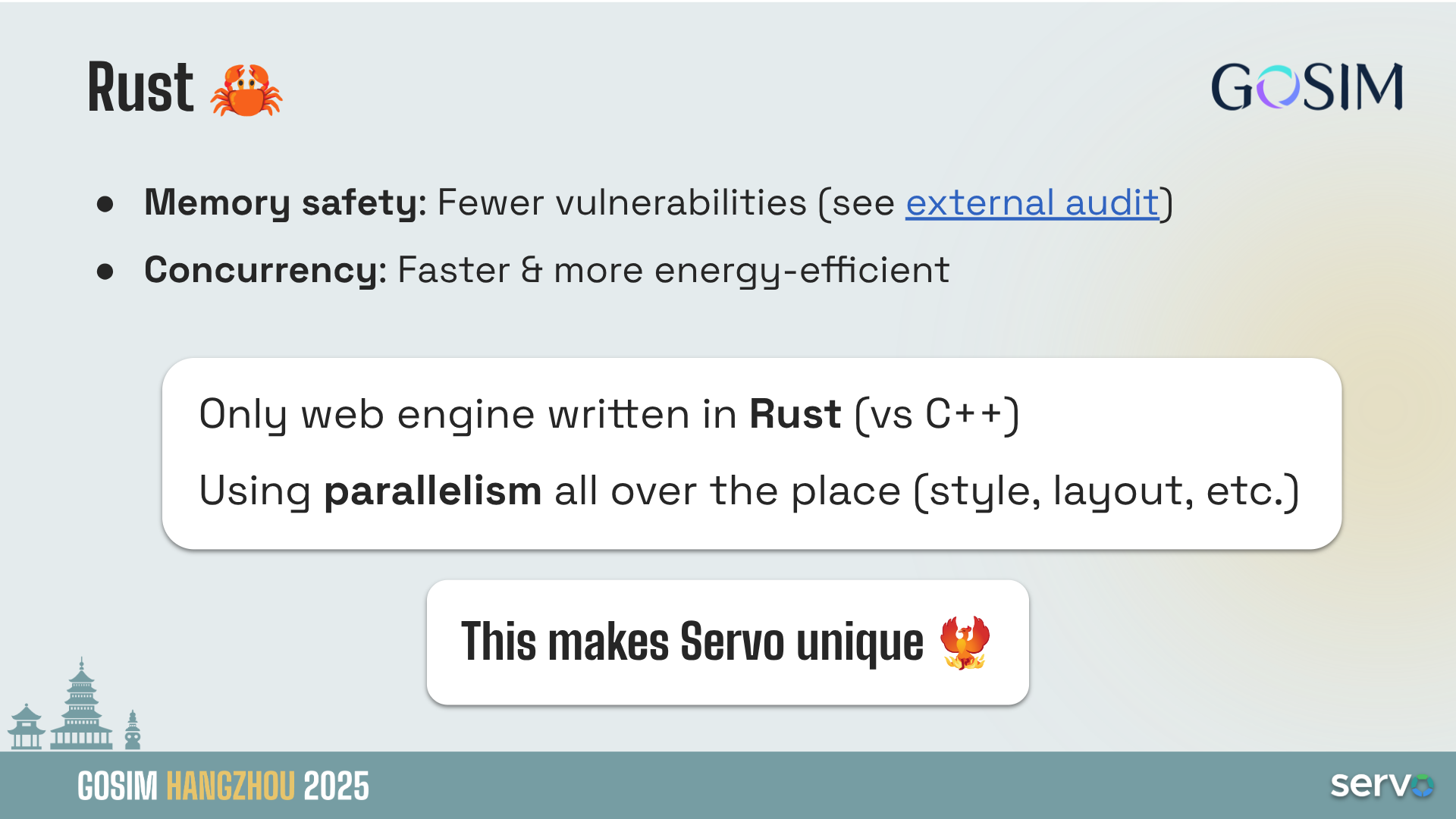
First and foremost, Servo is written in Rust which has two very special characteristics:
- Memory safety: Which means that you get less vulnerabilities related to wrong memory usage in your applications. We link to a small external audit that was run in a part of Servo and didn’t identify any important issue.
- Concurrency: Rust simplifies a lot the usage of parallelism in your applications, allowing you to write faster and more energy-efficient programs.
The highlights here are that Servo is the only web engine written in Rust (while the rest are using C++). And also the only one that is using parallelism all over the place (even when it shares some parts with Firefox like Stylo and WebRender, it’s the only one using parallelism in the layout engine for example).
All this is something that makes Servo unique compared to the rest of alternatives.
Independent 🦋 #

Another relevant characteristic of the project is its independence. Servo is hosted under Linux Foundation Europe and managed openly by the TSC. This is in opposition to other web engines that are controlled by big corporations (like Apple, Google and Mozilla), and share a single source of funding through Google search deals and ads.
On this regard, Servo brings new opportunities looking for a bright future on the open web.
Other features 🧩 #
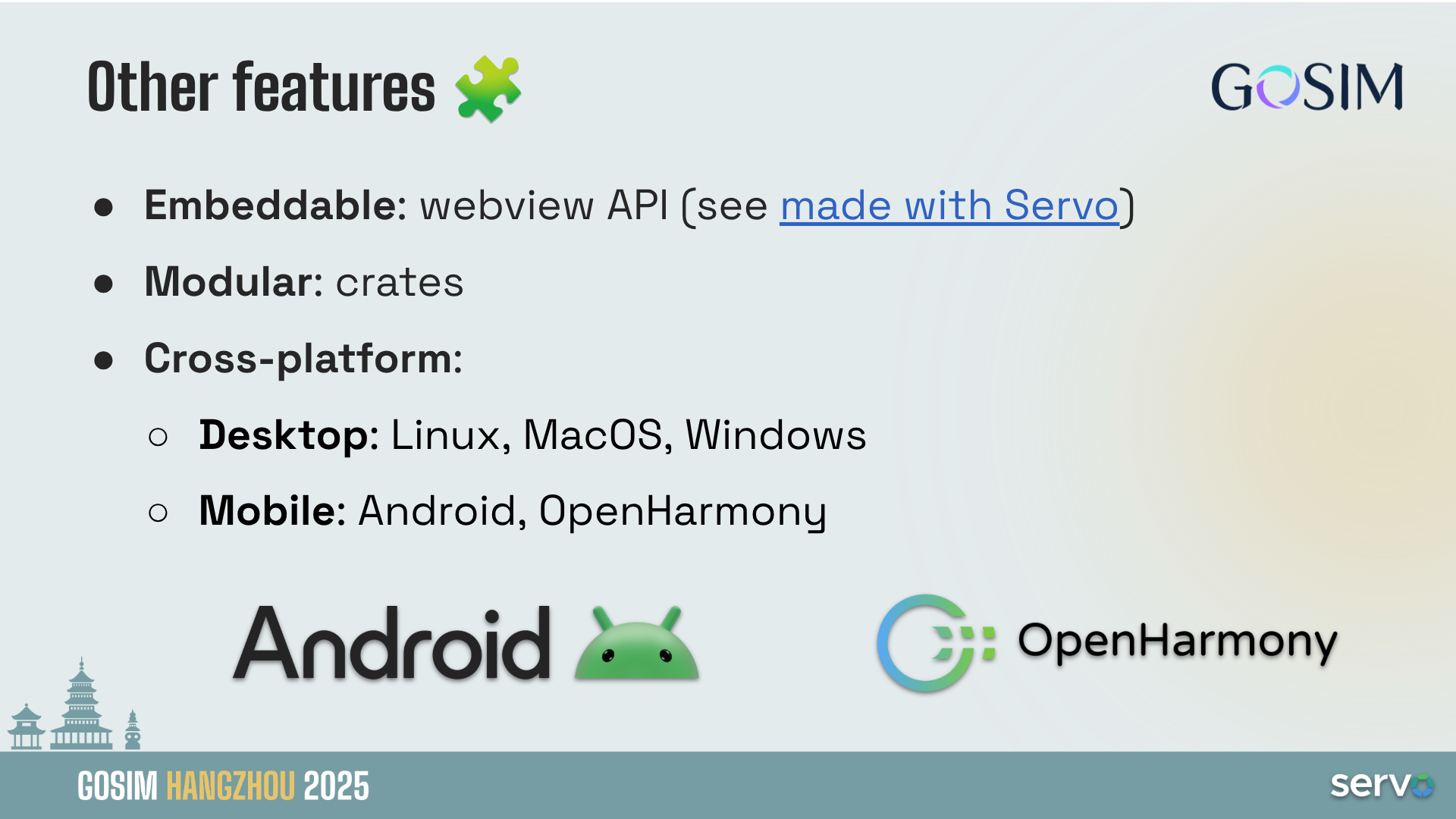
Other Servo features that are worth mentioning:
- Embeddable: Servo can be used to be embedded in other applications, it has a WebView API that is under construction. We link to the made with Servo page at servo.org where people can find examples.
- Modular: Servo has a bunch of crates (libraries) that are widely used in the Rust ecosystem. This modularity brings advantages and benefits the Servo project too. Some of these modules are shared with Firefox as mentioned previously.
- Cross-platform: Servo supports 5 platforms. Linux, MacOS, and Windows on the desktop; together with Andorid, and OpenHarmony on mobile.
What’s the project vision? 🎯 #

The next section talks about Servo plans and long-term vision, focusing on what the Servo community has been doing recently.
What are we doing today? 📌 #
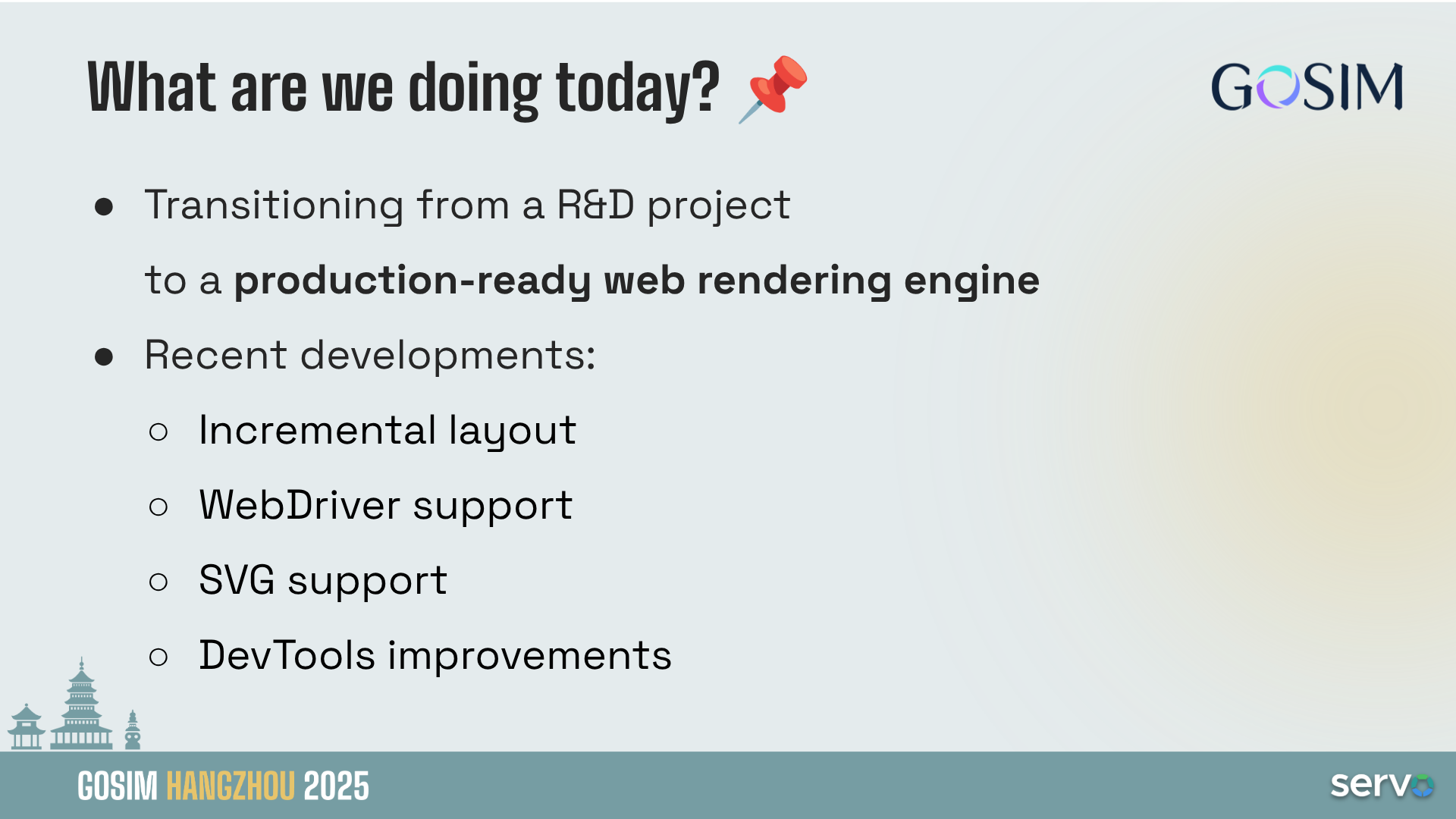
Servo is transitioning from a R&D project (how Mozilla created it originally) to a production-ready web rendering engine. There is a long path to go and we’re still walking it, the main goal is that the users start considering Servo as a viable alternative for their products.
We describe some of the recent developments. There are many more as the big community is working on many different things, but this is just a small set of relevant things that are being developed.
- Incremental layout: This is a fundamental feature of any web engine. It’s related to the fact that when you modify something in a website (some text content, some color, etc.), you don’t need to re-layout the whole website and re-compute the position of all the boxes, but only the things that were modified and the ones that can be affected by those changes. Servo has now the basis of incremental layout implemented which has clearly improved performance, though it still has room for further developments.
- WebDriver support: WebDriver is a spec that all the engines implement, which allows you to automate testing (clicking on a button, input some key strokes, etc.). This is a really nice feature to allow automation of tasks with Servo and improve testing coverage.
- SVG support: Many many websites use SVG, specially for icons and small images. SVG is a big and complex feature that would deserve its own native implementation, but so far Servo is using a third party library called resvg to add basic SVG support. It has limitations (like animations not working) but it allows to render much better many websites.
- DevTools improvements: Servo uses Firefox DevTools, this was totally broken in 2023 and there has been ongoing work to bring them back to life, and add support for more features like the networking and debugger panels. More work on this area is still needed in the future.
Organizational updates 🤝 #
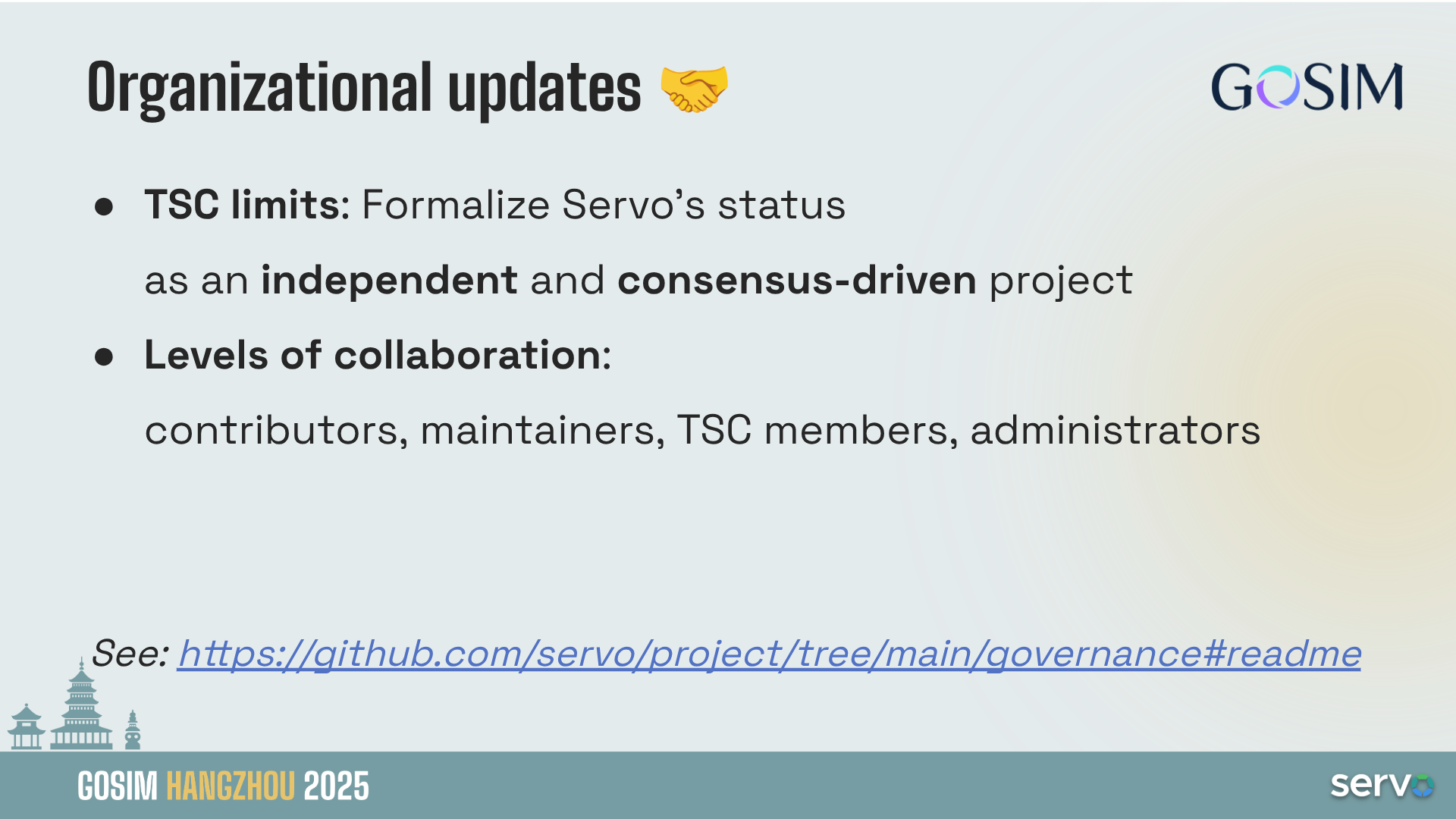
From the Servo governance point of view there has also been some changes recently. We have set some limits to the TSC in order to formalize Servo’s status as an independent and consensus-driven project. These changes cap the maximum number of TSC members and also limit the votes from the same organization.
The TSC has also defined different levels of collaboration within the project: contributors, maintainers, TSC members, and administrators. Since this was setup less than a year ago several people have been added to these roles (12 contributors, 22 maintainers, 17 TSC members, and 5 administrators). Thank you all for your amazing work!
You can find more details about this on the Servo project governance repository in GitHub.
Plans 💡 #
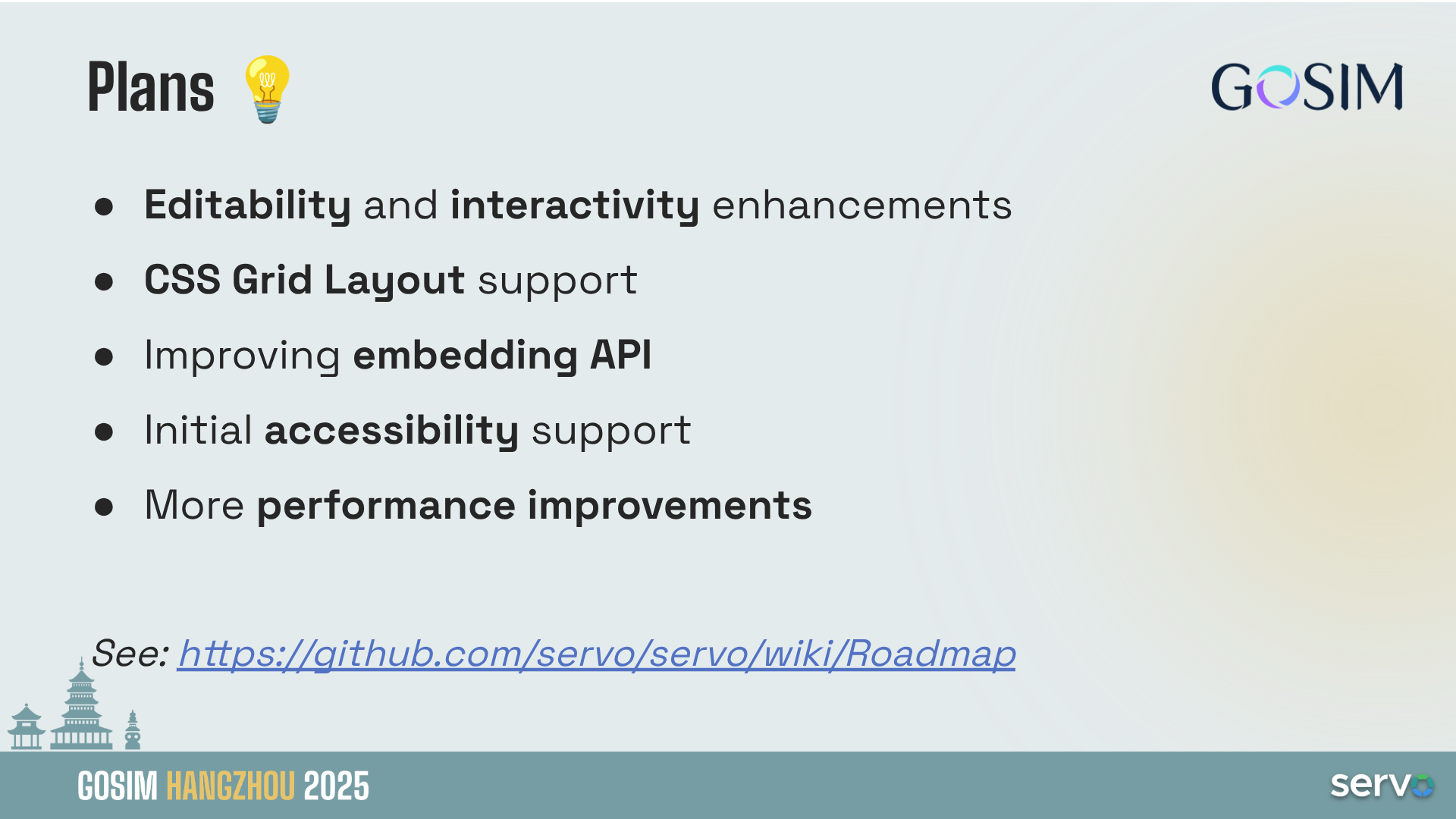
This reflects the plans from the Servo community for the next months. The main highlights are:
- Editability and interactivity enhancements: Things like selecting text or filling forms will be improved thanks to this work.
- CSS Grid Layout support: This is an important CSS feature that many websites use and its being developed through a third party library called taffy.
- Improving embedding API: As mentioned earlier this is key for applications that want to embedded Servo. We’re in the process of improving the API so we can have one that covers applications’ needs and allows us releasing versions of Servo to simplify usage.
- Initial accessibility support: Servo has zero accessibility support so far (only the servoshell application has some basic accessibility). This is a challenging project as usually enabling accessibility support has a performance cost for the end user. We want to experiment with Servo and try to minimize that as much as possible, exploring possibilities of some innovative design that could use parallelism for the accessibility support too.
- More performance improvements: With incremental layout things have improved a lot, but there are still plenty of work to do in this area where more optimizations can be implemented.
For more details about Servo’s roadmap check the wiki. The Servo community is discussing it these days, so there might be updates in the coming weeks.
Long-term vision 🔭 #
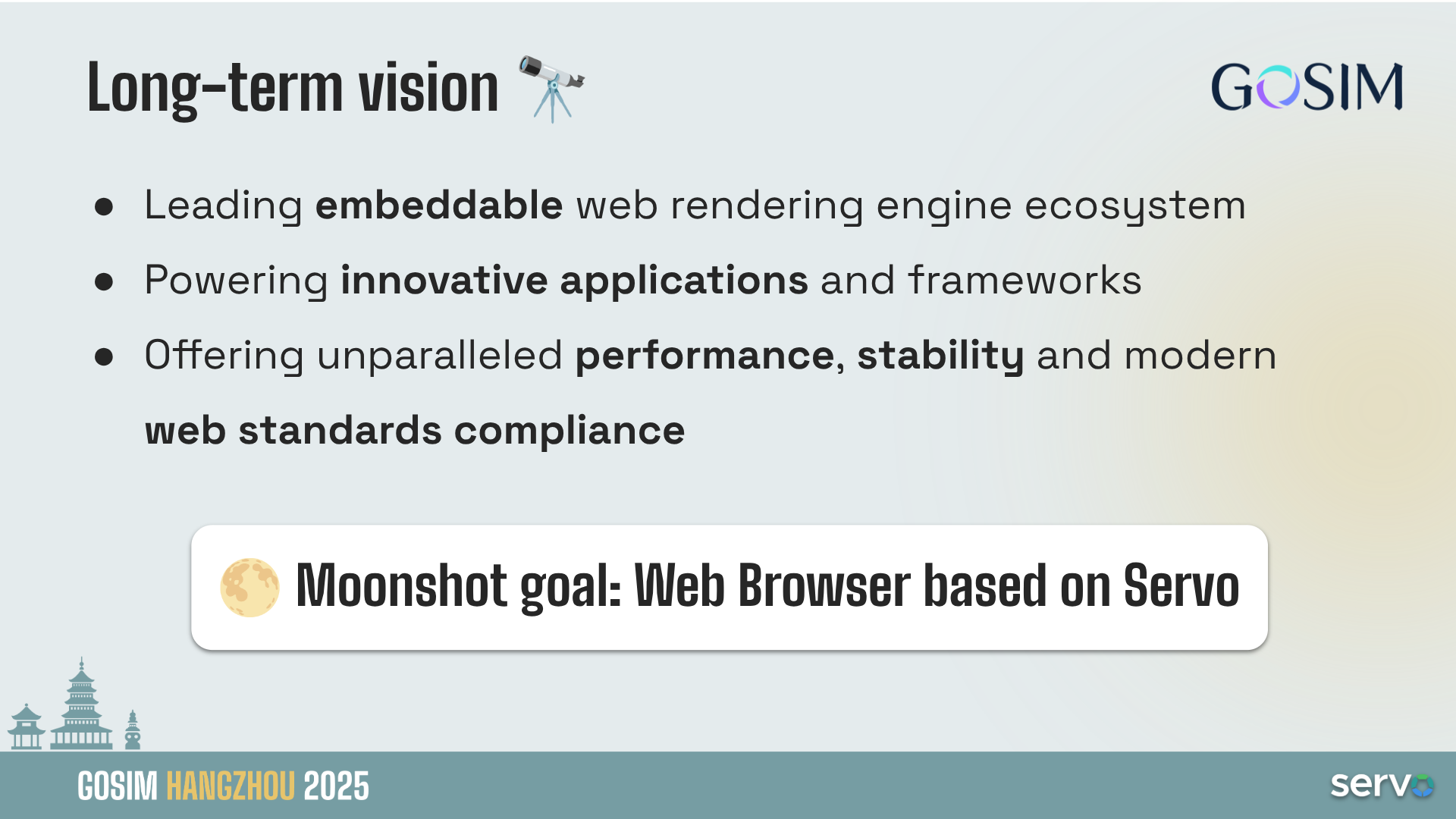
Here we take a look to some years ahead and what we want to do with Servo as a project. Servo’s vision could be summarized as:
- Leading the embeddable web rendering engines ecosystem: There are plenty of devices that need to render web content, Servo has some features that make it a very appealing solution for these scenarios.
- Powering innovative applications and frameworks: Following Servo’s R&D approach of exploring new routes, Servo could help to develop applications that try new approaches and benefit from Servo’s unique characteristics.
- Offering unparalleled performance, stability and modern web standards compliance: Servo aims to be a very performant and stable project that complies with the different web standards.
As a moonshot goal we can envision a general purpose web browser based on Servo, knowing this would require years of investment.
How can you help? 🛟 #

To close the presentation I was mentioning some ways about how people, with different profiles, can help the project.
Join the project 🔗 #
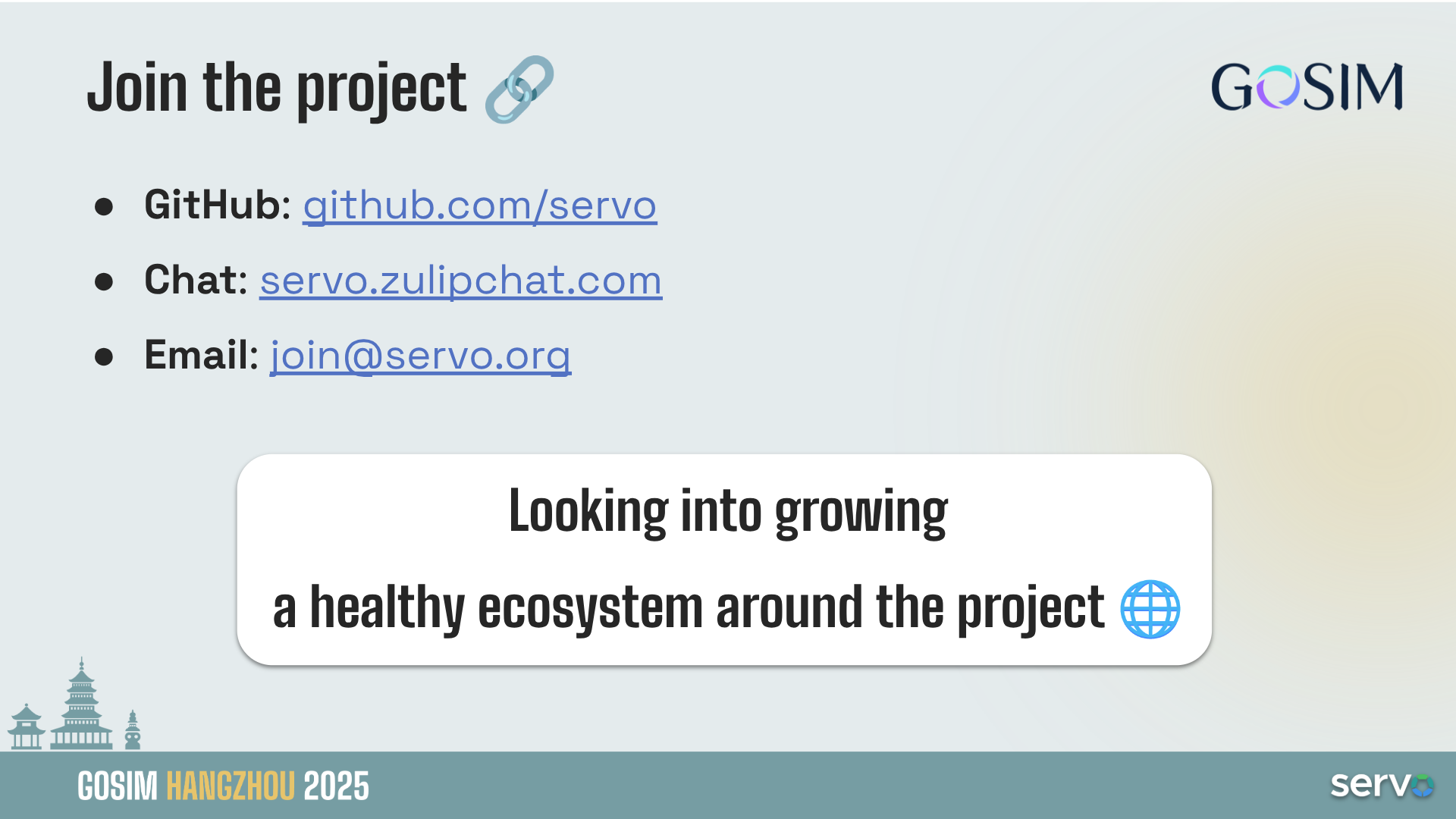
One option is to join the project as a contributor, if you are a developer or an organization interested in Servo, you could join us by visiting our GitHub organization, asking questions or doubts in the Zulip chat, and/or emailing us.
Servo is very welcoming to new contributors and we’re looking into growing a healthy ecosystem around the project.
Test Servo and report issues 🧪 #
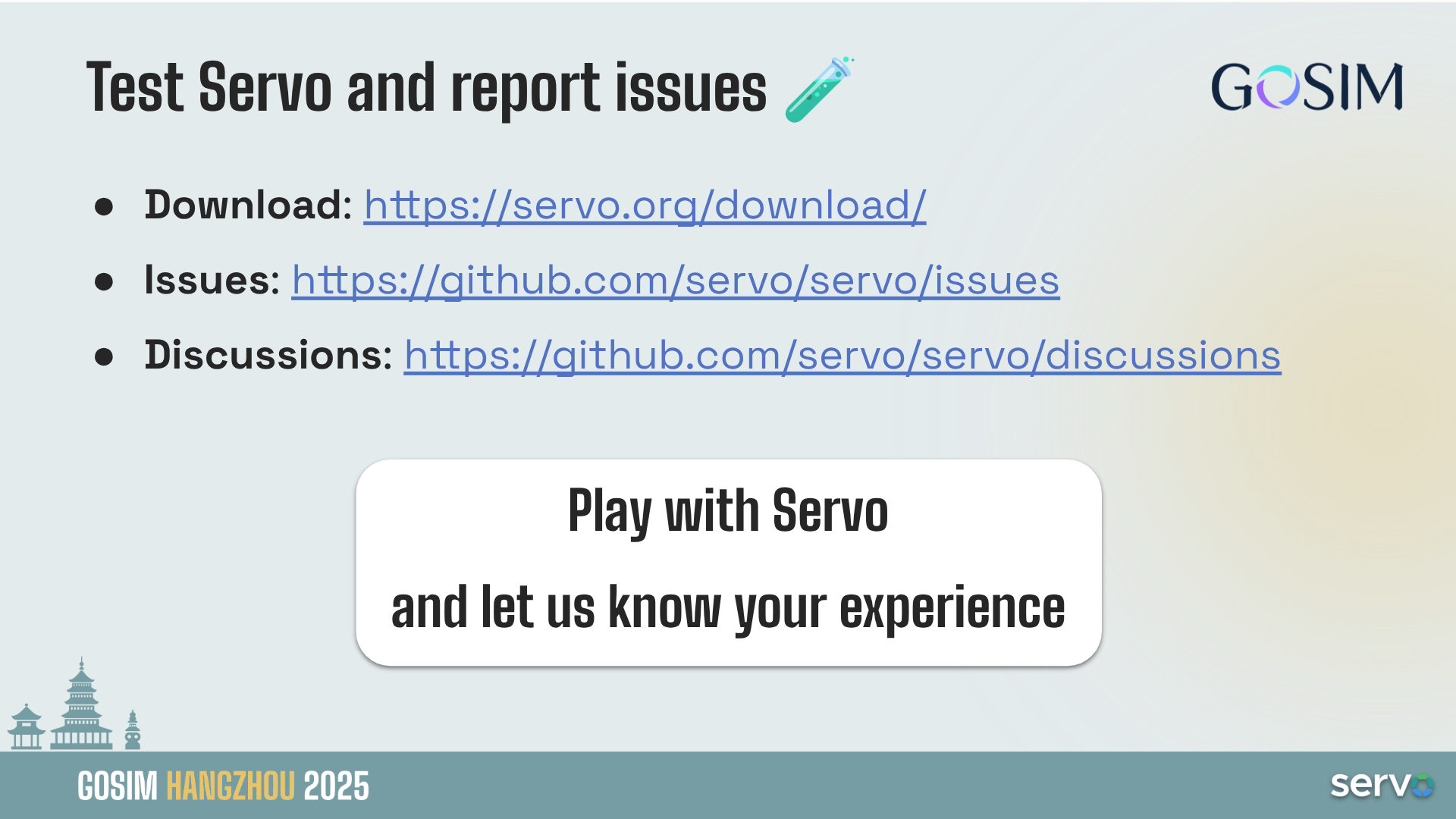
Another option as a regular user is to download Servo and report issues or participate in the project discussions at GitHub.
There are nightly binaries so you can easily play with Servo and let us know your experience.
Follow us & spread the word 📢 #

Of course another way of helping the project is to talk about it, and spread the news about the project. We wrote weekly updates on social media, monthly blog posts with very detailed information about progress in the project. Every now and then we also produce some other content, like talks or specific blog posts about some topic.
You can follow Servo at servo.org, Mastodon, Bluesky, and LinkedIn.
Sponsor the project 💰 #
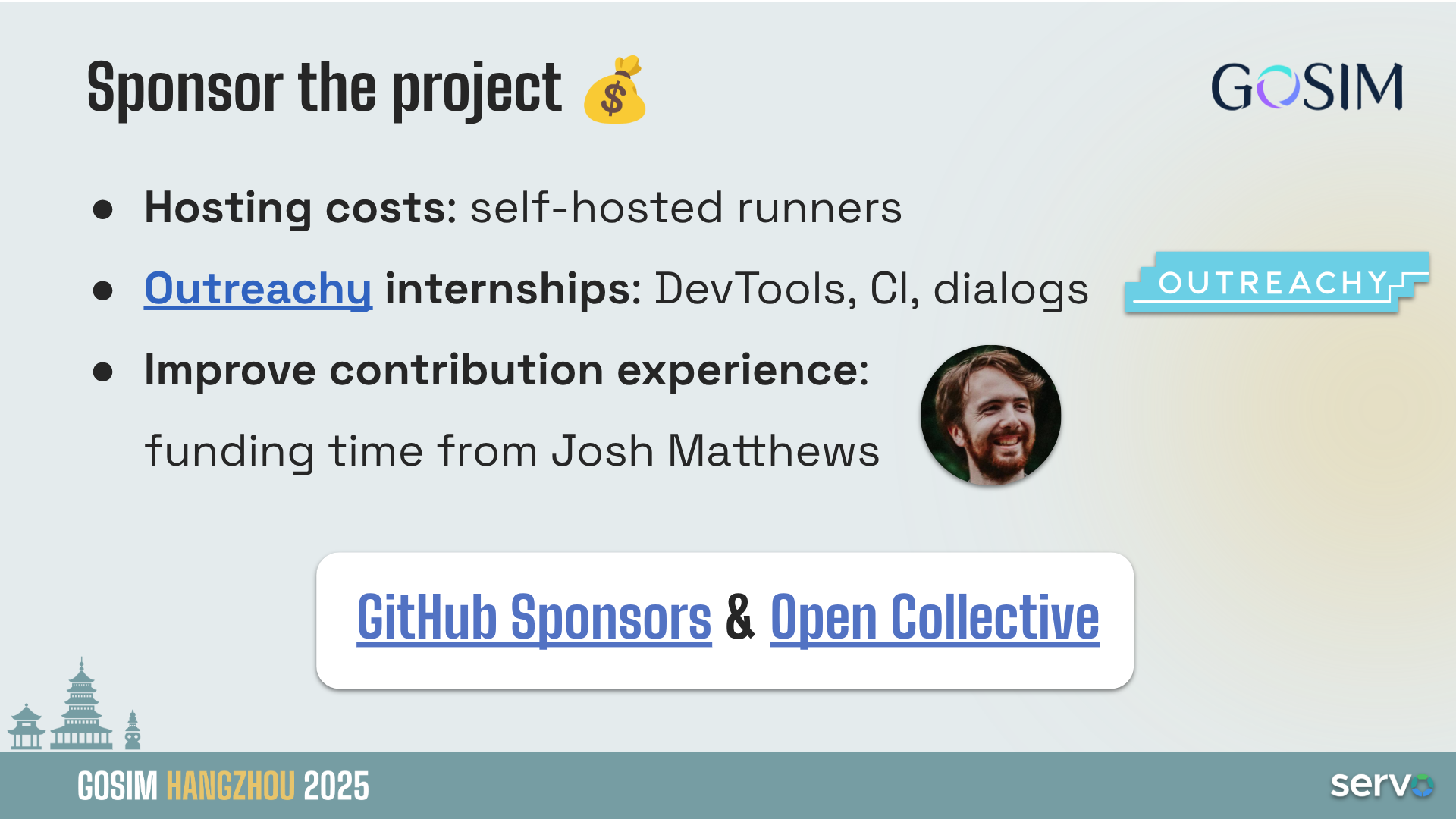
And last, but not least, you can donate money to the Servo project as both an individual or an organization. We have two options here: GitHub sponsors and Open Collective. And if you have special needs you can always contact the project or contact Igalia to enquiry about it.
We are very grateful to all the people and companies that have been sponsoring Servo. Next is how we’re using the money so far:
- Hosting costs: Servo is a big project and we have needs to rent some servers that are used as self-hosted runners to improve CI times. We’re also looking into setting up some dedicated machine to benchmark Servo’s performance.
- Outreachy internships: Outreachy is an amazing organization that provides internships to participate in open source projects. Servo has been part of Outreachy in the past, and again since 2023. Our recent interns have worked on DevTools enhancements, CI improvements, and better dialogs on servoshell. We have used Servo’s Open Collective money to sponsor one internship so far, and we’re looking into repeating the experience in the future.
- Improve contribution experience: Since this month we have started funding time from one of the top Servo experts, Josh Matthews (@jdm). The goal is to improve the experience for Servo contributors, Josh will put effort in different areas like reducing friction in the contribution process, removing barriers to contribution, and improving the first-time contribution experience.
Thank you #

Finally closing the talk saying thanks and with a QR code linking to Servo’s homepage.
Questions #
After the talk there was only a question from the audience asking if Mozilla could consider replacing Gecko by Servo once Servo gets mature enough. My answer was that I believe the original plan from Mozilla when they started Servo was that, but since they stopped working on the project is not clear if something like that could happen. It’d be indeed really nice if something like this can happen in the future.
There were a couple of more people that approached me after the talk to comment some bits of it and congratulate us for the work on the project. Thank you all!
- Previous: Short 3
- Next: Short 2025-12-02